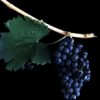In the preface to one if his guides, Hugh Johnson offers the following recommendation: ‘If you love Burgundy, then try Malbec.’ He goes on to say that Burgundy fans’ fascination with the famous region is hard to match. The crunchy red fruits, minerals mixed with spices and the perfect core of floral fragrances are all qualities of wines from the area. But, he says, Malbec descriptors – aromas and flavours – aren’t so very different from Pinot Noir. And there are even similarities with the structure: ‘Acidity, firmness and a smooth as silk body.’
Malbec is one of the most interesting grapes in the world. It has precise, well-defined aromas that may well be found individually in other grapes but never all together. Its unique descriptors have seduced many a consumer.
Many different Malbecs
Malbec originally comes from the southwest of France. Today, it barely exists in Bordeaux but is planted extensively in Cahors. There are also some good examples from the Loire Valley, especially Touraine. Studied and admired by Masters of Wine and Master Sommeliers, it is a classic in the world of wine.
The more we learn about the soils and effect of altitude, temperature, light, harvest times and winemaking styles, the better we can describe and define different Malbecs. As we set out to learn more about how the grape behaves in Argentina, we find that rather than a single kind of Malbec, there are many.
There are three key points to understanding the aromatic possibilities of the varietal. Firstly, over the past eight years, winemakers have begun to question the traditional harvest time, choosing instead to pick when the grape is just ripe (rather than overripe) for winemaking, a date that changes depending on what area you’re in. This new approach has revealed many new facets to Malbec, especially its fresher side.
Secondly, another of the big changes has been to remove wood from the winemaking process. Stripped bare, Malbec reflects the terroir far more closely allowing us to detect the spicy aromas that it has to offer.
The third point is a much better understanding of the soil, leading to a more balanced plant. The introduction of tailored irrigation strategies and studying exactly what the vines need have been great strides in achieving balance, maturity and the development of aromatic precursors.
Martín Kaiser, an Argentine winemaker, recently led a study of how Malbec behaves in different regions of the country. The results show that soil is a fundamental factor in the development of aromas as it affects temperature and lends different textures.
The Malbec descriptors map
Malbecs can be very different depending on which part of Mendoza they come from. For example, in Luján de Cuyo we find wines with pronounced red fruits and a little ripe black fruit evoking plums and red fruit jam. Violet floral notes are a key characteristic while the spicy aromas are more moderate. You might also find a hint of pink pepper among Luján de Cuyo Malbec descriptors.
Moving further to the east of Mendoza, in lower areas with deeper soils, the profiles of the Malbecs also contain red fruit jams but are now accompanied by aromatic herbs such as oregano and thyme as well as riper, softer tannins.
In the Uco Valley, in higher areas with greater yields, dark fruit is more prominent and it is accompanied by fresh aromas such as eucalyptus, white pepper, aromatic herbs and powerful gusts of violet. The stonier soils bring out the herbs while the limestone concentration results in a fruitier, spicier profile.
Malbec takes on a distinctive, unique profile in the Calchaquí Valleys: in addition to stewed red fruit, it offers fragrances of dried tomato, paprika and slightly smoky notes.
Patagonia is a vast area but in general Malbecs from the Río Negro region present a similar profile to the Uco Valley although they differentiate themselves in the mouth with more powerful floral aromas. In the Neuquén area, the Malbecs are similar to those from East Mendoza.
Every day we’re learning more about Malbec descriptors and its different profiles and expressions in each area. Terroir is very important and the more we know about them, the more faces of Malbec we’ll be able to identify and develop.
Ph. Bodega Trapiche



